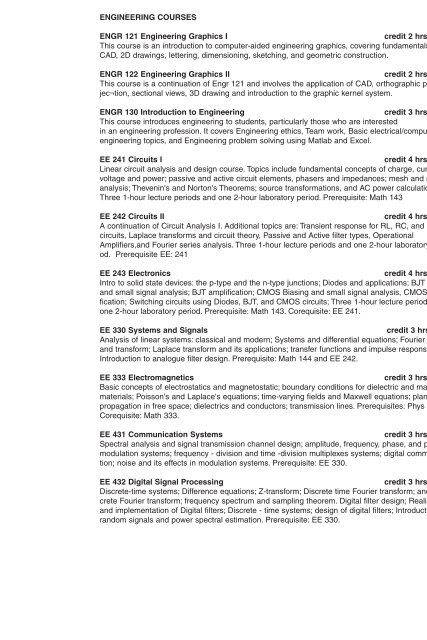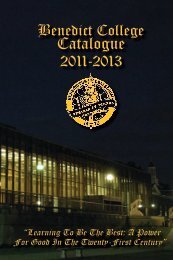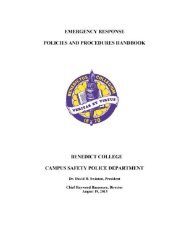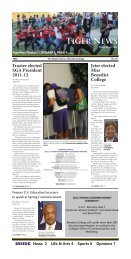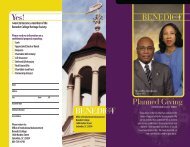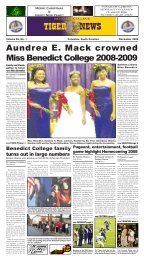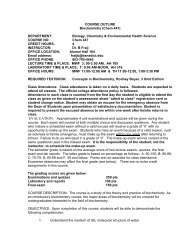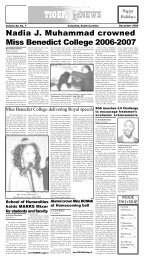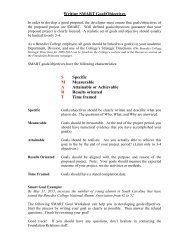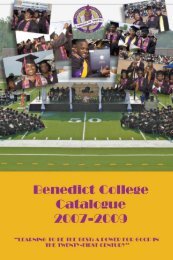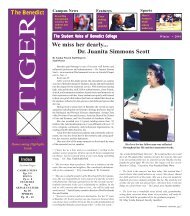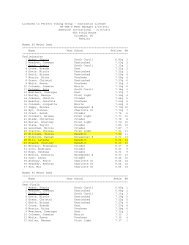2009-2011 - Benedict College
2009-2011 - Benedict College
2009-2011 - Benedict College
Create successful ePaper yourself
Turn your PDF publications into a flip-book with our unique Google optimized e-Paper software.
PHYSICS AND ENGINEERING DEPARTMENT 251<br />
ENGINEERING COURSES<br />
ENGR 121 Engineering Graphics I<br />
credit 2 hrs.<br />
This course is an introduction to computer-aided engineering graphics, covering fundamentals of<br />
CAD, 2D drawings, lettering, dimensioning, sketching, and geometric construction.<br />
ENGR 122 Engineering Graphics II<br />
credit 2 hrs.<br />
This course is a continuation of Engr 121 and involves the application of CAD, orthographic projec¬tion,<br />
sectional views, 3D drawing and introduction to the graphic kernel system.<br />
ENGR 130 Introduction to Engineering<br />
credit 3 hrs.<br />
This course introduces engineering to students, particularly those who are interested<br />
in an engineering profession. It covers Engineering ethics, Team work, Basic electrical/computer<br />
engineering topics, and Engineering problem solving using Matlab and Excel.<br />
EE 241 Circuits I<br />
credit 4 hrs.<br />
Linear circuit analysis and design course. Topics include fundamental concepts of charge, current,<br />
voltage and power; passive and active circuit elements, phasers and impedances; mesh and nodal<br />
analysis; Thevenin's and Norton's Theorems; source transformations, and AC power calculations.<br />
Three 1-hour lecture periods and one 2-hour laboratory period. Prerequisite: Math 143<br />
EE 242 Circuits II<br />
credit 4 hrs.<br />
A continuation of Circuit Analysis I. Additional topics are: Transient response for RL, RC, and RLC<br />
circuits, Laplace transforms and circuit theory, Passive and Active filter types, Operational<br />
Amplifiers,and Fourier series analysis. Three 1-hour lecture periods and one 2-hour laboratory period.<br />
Prerequisite EE: 241<br />
EE 243 Electronics<br />
credit 4 hrs.<br />
Intro to solid state devices: the p-type and the n-type junctions; Diodes and applications; BJT Biasing<br />
and small signal analysis; BJT amplification; CMOS Biasing and small signal analysis, CMOS amplification;<br />
Switching circuits using Diodes, BJT, and CMOS circuits; Three 1-hour lecture periods and<br />
one 2-hour laboratory period. Prerequisite: Math 143. Corequisite: EE 241.<br />
EE 330 Systems and Signals<br />
credit 3 hrs.<br />
Analysis of linear systems: classical and modern; Systems and differential equations; Fourier series<br />
and transform; Laplace transform and its applications; transfer functions and impulse response;<br />
Introduction to analogue filter design. Prerequisite: Math 144 and EE 242.<br />
EE 333 Electromagnetics<br />
credit 3 hrs.<br />
Basic concepts of electrostatics and magnetostatic; boundary conditions for dielectric and magnetic<br />
materials; Poisson's and Laplace's equations; time-varying fields and Maxwell equations; plane wave<br />
propagation in free space; dielectrics and conductors; transmission lines. Prerequisites: Phys 244.<br />
Corequisite: Math 333.<br />
EE 431 Communication Systems<br />
credit 3 hrs.<br />
Spectral analysis and signal transmission channel design; amplitude, frequency, phase, and pulse<br />
modulation systems; frequency - division and time -division multiplexes systems; digital communication;<br />
noise and its effects in modulation systems. Prerequisite: EE 330.<br />
EE 432 Digital Signal Processing<br />
credit 3 hrs.<br />
Discrete-time systems; Difference equations; Z-transform; Discrete time Fourier transform; and discrete<br />
Fourier transform; frequency spectrum and sampling theorem. Digital filter design; Realization<br />
and implementation of Digital filters; Discrete - time systems; design of digital filters; Introduction to<br />
random signals and power spectral estimation. Prerequisite: EE 330.


